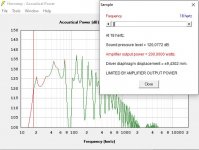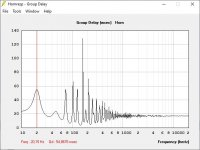Technically, the BFM Table Tuba is a BP4 with a flared port. That flared port is the horn, hence Tuba.
A Tapped Horn is a series tuned BP6. The whole enclosure is a positive flared port.
Last edited:
Those parameters wont line up any peerless 10" i know, what model it is?
Xls 12" worked well on 4th order bandpass 0.3something qts driver
Xls 12" worked well on 4th order bandpass 0.3something qts driver
Patrick and friends, how would this 10" peerless do in a triple reflex?
It would make a very large and very potent hometheater subb if pushed into a corner. 😀
It is an 8th order BP (triple reflex but with quarter wave resonators).
Attachments
Groupdelay measures in minute scale?
Yes! If you live in a large cathedral.
I consider 55 ms at 20 Hz to be inaudible, since room acoustics will swamp this by a large margin at these frequencies.
Attachments
@circlomannen here's a 2pi model comparison of the max spl of your design to the table tuba with the peerless xxls
20hz tt 99.5 8th 114
30hz tt 114 8th 113
40hz tt 118 8th 119
So yours kills it down low just not sure I want to build a 300 liter box and have 44ms group delay at 71hz.
20hz tt 99.5 8th 114
30hz tt 114 8th 113
40hz tt 118 8th 119
So yours kills it down low just not sure I want to build a 300 liter box and have 44ms group delay at 71hz.
Groupdelay measures in minute scale?
if you reduce the cross-sectional area or the length as needed to induce a lower Heimholz from that chambers contribution to the pass band you could see something you might prefer. Or try this as a tapped HORN with a very long and Large L45 in hornresp too(you can add a flare?).
Yes! If you live in a large cathedral.
I consider 55 ms at 20 Hz to be inaudible, since room acoustics will swamp this by a large margin at these frequencies.
stick a few units of filling in each segment to back off the unobtanium rigidity and lossless HORNRESPONCE modeling peaks? its a fair example and likely helps a bit here.
- Home
- Loudspeakers
- Subwoofers
- Post Your Triple Reflex Bandpass Designs


